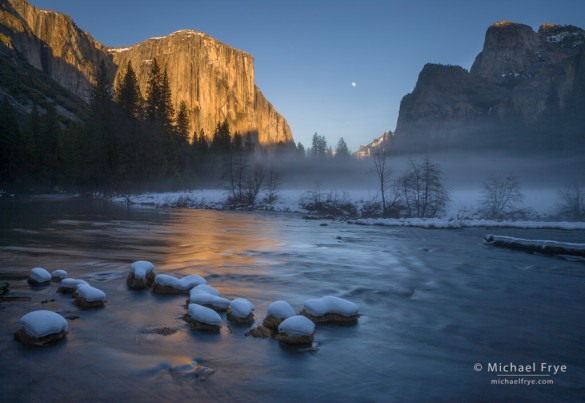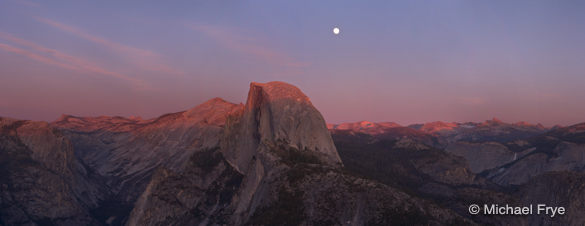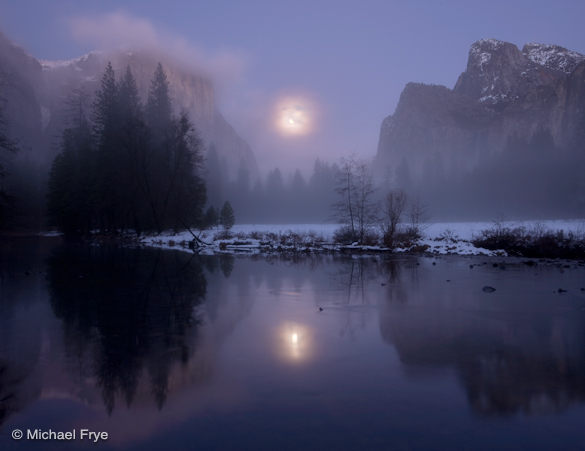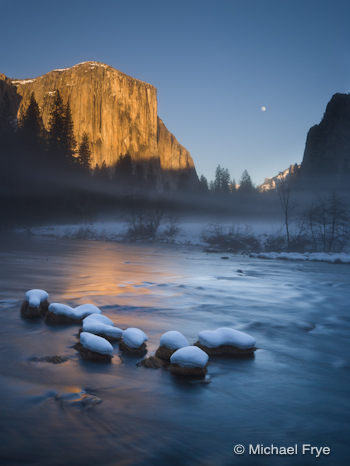by Michael Frye | Nov 26, 2013 | Composition, Photography Tips, Vision and Creativity

Moon rising between El Capitan and Cathedral Rocks from Valley View. What’s the least interesting part of this image?
The best compositions are simple; they present only the essentials, and leave out extraneous clutter. The most common mistake in photography – by far – is including too much in the frame. Anything that’s not adding to the photograph’s message is detracting from it.
To help simplify your compositions, ask yourself, before you press the shutter, “What’s the least interesting part of this photograph?” Try to identify the weakest area of your composition, and find a way to get rid of it. Then, once you’ve done that, ask the same question again: “Now, what’s the least interesting part of this image?” And get rid of that. And keep doing that until there’s nothing left that you could possibly cut out without losing something vital.
To give you some practice, look at the photograph above. What’s the least interesting part of that image? And if you got rid of that, what would be next – what’s the next least interesting part of the photograph?
I’ll give you a minute to think about it. When you’re ready, take a look at this next photograph, and answer the same question: what’s the least interesting part of this image?
(more…)
by Michael Frye | Jan 12, 2012 | Photography Tips, Yosemite Photo Conditions

Moonrise from Glacier Point Saturday evening
In my post last Thursday I mentioned that there might be a good opportunity to photograph the moonrise from Glacier Point on Saturday evening. So Claudia and I went to Glacier Point that night, where we met lots of photographers. It was nice to see familiar faces, and meet some online acquaintances in person. Thanks to all of you who came up to me and said hello!
Of course in between socializing we all photographed the moon rising behind Half Dome. My favorite image from this evening is the panorama above (stitched together from five separate frames). If you were there, I’d love to see the images you made, so please post a link in the comments. And if you photographed the moon somewhere else, I’d like to see those images too!
(more…)
by Michael Frye | Aug 10, 2011 | Travels and Stories

Rising Moon, Gates of the Valley
Not every photo has an interesting story behind it, but the approaching full moon reminded me of the eventful day I had before making this image from Gates of the Valley in Yosemite.
I had been skiing at Badger Pass, and while gliding to the top of the Red Fox run I saw a snowboarder out of the corner of my eye. He was facing left, making a right turn into my path, and moving fast. He clearly didn’t see me and I didn’t have time to turn, so I yelled, “Look out!” and braced for impact.
(more…)
by Michael Frye | Jan 19, 2011 | Yosemite Photo Conditions

The moon rising between El Capitan and Cathedral Rocks from Valley View
Clear skies have allowed my workshop students and me to photograph the rising moon on three successive days: over Half Dome on Sunday, between El Capitan and Cathedral Rocks on Monday, and between Half Dome and El Capitan from Tunnel View yesterday. Naturally the timing for this workshop (Photoshop and Digital Printing, with The Ansel Adams Gallery) was planned to take advantage of these lunar opportunities, but you never know what kind of weather you’ll get, so we’ve been lucky.
Where November and December were exceptionally wet, January has been dry so far. Yosemite photographers often hope for precipitation and the opportunity to photograph a clearing storm, but every set of conditions creates unique opportunities. The clear, warm weather is melting the abundant snow pack and producing an exceptionally high flow in Yosemite Falls. It looks more like March than January. The light, however, is still at its winter angles, striking the falls shortly after sunrise—much better than in March, when the sun doesn’t reach the waterfall until it’s high in the sky.
With more clear, warm weather in the forecast, the water flow should stay high or even increase, and we could have great opportunities to photograph Yosemite Falls for several weeks.
If you had a chance to photograph the rising moon the last few days, or the high water in Yosemite Falls this winter, I’d love to see the images, so please post a link in the comments.












